Archive:Enlargement countries - education statistics
Data extracted in May 2023.
Planned article update: June 2024.
Highlights
In 2021, Türkiye had the highest share of early leavers from education and training in the Western Balkans and Türkiye region, with 27.5 % of young men and 25.8 % of young women (aged 18-24 years).
Among the Western Balkans and Türkiye, Montenegro had the highest share of persons aged 20-24 that had completed at least an upper secondary education level (96.1 %) in 2021; the lowest share was in Albania (56.1 %).
Across the Western Balkans and Türkiye, more men than women graduated from tertiary education in science and technology disciplines in 2021. The highest share of female graduates was in North Macedonia, with 48.4 %.
Persons aged 30-34 years having completed tertiary education or equivalent, 2011 and 2021
This article is part of an online publication and provides information on a range of education statistics for the Western Balkans and Türkiye and compares this with the corresponding data for the European Union (EU). Within this region, Bosnia and Herzegovina, Montenegro, North Macedonia, Albania, Serbia and Türkiye are candidate countries, while Kosovo* has the status of potential candidate.
Data for Georgia, Moldova and Ukraine, granted candidate status or European perspective by the European Council in June 2022, are not included in this article; Statistics Explained articles on the European Neighbourhood Policy-East countries are available here.
The article gives an overview of developments in the education sector, presenting an analysis of the different educational levels in terms of enrolment, educational attainment and tertiary education.
* This designation is without prejudice to positions on status, and is in line with UNSCR 1244/1999 and the ICJ Opinion on the Kosovo Declaration of Independence.
Full article
Number of pupils and students
Among the Western Balkans and Türkiye, Türkiye was the only country with an increase in the number of pupils attending (up to and including) upper secondary education (ISCED 2011 levels 0-3) in the period 2013-2021, increasing each year except 2021 during this period. The number of pupils in Türkiye reached 18.1 million in 2021, representing an increase of 12.0 % compared to 2013. Serbia recorded a continuous decrease in enrolments between 2013 and 2021, except for 2018 when the numbers only marginally changed. Serbia registered 982 300 pupils in 2021, a decrease of 5.7 % compared to 2013. Albania also reported a constant decrease in enrolments between 2013 and 2021, from 627 100 pupils in 2013 to 465 800 in 2021. This represented a drop of 25.7 % over this period, the highest fall among the Western Balkans and Türkiye. Kosovo experienced a negative trend in the number of pupils throughout the period 2013-2021, registering an overall decrease of 20.3 % between 2013 (420 400 pupils) and 2021 (335 300 pupils). For Bosnia and Herzegovina data availability is limited to only three years of the period but it also saw a reduction in the number of pupils attending up to and including upper secondary education, falling from 432 900 pupils in 2018 to 406 200 in 2021, a decrease by 6.2 % between these two years. From 2013 to 2021, the number of pupils enrolled in North Macedonia declined through most of the period, except for increases in 2017 (+1.1 %) and 2021 (+2.4 %). Compared to 2013, the number of pupils in North Macedonia decreased by 6.9 % to 292 100 pupils in 2021. Montenegro recorded 116 900 pupils in 2021, 1.6 % lower than the previous year, following a period of sustained growth in the number of pupils from 2017 to 2020. Compared to 2015, the number of pupils in Montenegro was only 1.6 % higher in 2021.
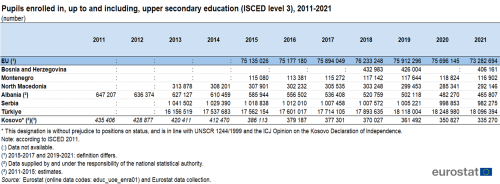
(number)
Source: Eurostat (educ_uoe_enra01) and Eurostat data collection
Overall, in 2021, there were approximately 20.7 million pupils enrolled in — up to and including — upper secondary education in Western Balkans and Türkiye; this was equivalent to over one quarter (28.2 %) of the total number of pupils enrolled up to and including upper secondary education in the EU, which was 73.3 million in 2021.
While the absolute number of pupils and students is closely linked to the size and age structure of populations, there is a range of other factors that influence how long students remain in the education system, such as the length of compulsory schooling, opportunities in the labour market and the availability and cost of tertiary education. In recent years, policy interest has focused on encouraging young people to remain within educational systems so they may develop skills and gain qualifications that may help in the search for work in an increasingly knowledge-driven economy.
Early leavers from education and training
Figure 1 presents the share of early leavers (who finished at most a lower secondary education and were not involved in further education or training) from education and training among persons aged 18-24 years by gender in 2011 and 2021.
The proportion of early leavers from education and training among persons aged 18-24 was highest in Türkiye, with 27.5 % of young men and 25.8 % of young women in 2020 (no 2021 data available). These proportions were also relatively high in Albania with 17.8 % of young men and 17.1 % of young women in 2021. However, there were lower proportions of early leavers from education and training in Serbia (7.4 % of young men and 5.2 % of young women in 2021) and North Macedonia (5.7 % of young men and 5.8 % of young women in 2020). This was followed by still lower shares of early leavers in Montenegro, 5.2 % of young men and 4.9 % of young women in 2019 (more recent data not available), and in Bosnia and Herzegovina, 4.9 % of young men and 4.4 % of young women in 2021. In Kosovo, 7.0 % of young men were early leavers and 7.0 % of young women in 2021. In comparison, the proportion of early leavers from education and training in 2021 stood at 11.5 % in the EU among young men and 8.0 % among young women.
Türkiye, Albania, Serbia, Montenegro and Bosnia and Herzegovina registered a higher proportion of early leavers for young men than for young women, as well as the EU, whereas in North Macedonia, and Kosovo the proportions of early leavers among young men and young women were almost equal.
Between 2011 and 2021 (or most recent year available), all Western Balkans and Türkiye recorded decreases in their shares of early leavers. Albania and Türkiye recorded the highest changes: in Albania, the proportion of early leavers decreased by 15.5 percentage points (pp) for young men and by 20.6 pp for young women, reversing the gender gap from +4.4 pp in 2011 to -0.7 pp in 2021; in Türkiye, the proportion of early leavers decreased by 10.2 pp for men and by 19.9 pp for women, reverting the gender gap from +8.0 pp in 2011 to -1.7 pp in 2020 (2021 data not available). North Macedonia registered a smaller change in the proportion of early leavers for young men than for young women between 2011 and 2020 (2021 data not available) (-6.2 pp and -9.4 pp, respectively), reducing the gender gap from +3.3 pp in 2011 to only 0.1 pp in 2020 (2021 data not available). Bosnia and Herzegovina’s proportion of early leavers also decreased, by 3.3 pp for young men and equally by 3.3 pp for young women; the gender gap remained the same in both 2011 and 2021 and was -0.5 pp. Data for Montenegro showed also a reduction in early leavers for men (-2.4 pp) and for women (-1.7 pp) between 2011 and 2019 (most recent data available), narrowing the gender gap from -1.0 pp in 2011 to -0.3 pp in 2019 (most recent data available). In Serbia, the proportion of early leavers decreased a little bit more for men (by 2.2 pp) than for women (by 2.0 pp) between 2011 and 2021, slightly shifting the gender gap from -2.4 pp in 2011 to -2.2 pp in 2021. The proportion of early leavers declined also in Kosovo between 2012 (earlier data not available) and 2021, by 8.7 pp for young men and by 14.6 pp for young women; the gender gap dropped down from +5.9 pp in 2012 to gender parity in 2021. EU’s proportion of early leavers for both young men and young women decreased between 2011 and 2021 by 3.7 pp and 3.1 pp, respectively, reducing the gender gap from -4.1 pp to -3.5 pp.

(% of 18-24 year-old men/women)
Source: Eurostat (edat_lfse_14) and Eurostat data collection
Youth education attainment
An alternative measure for analysing the outcomes of education systems is the youth education attainment level. This indicator is defined as the proportion of 20-24 year olds who have achieved at least an upper secondary level of education attainment (at least ISCED level 3). Data by gender are presented in Figure 2 as well as for the total population.
In 2021 (or most recent data available), there were four countries among Western Balkans and Türkiye which reported a higher proportion of persons aged 20-24 having attained at least an upper secondary level of education, compared to the EU. Those were Montenegro (96.1 %; 2020 data) and North Macedonia (93.9 %; 2020 data), Bosnia and Herzegovina (93.9 %) and Serbia (93.3 %). A considerably lower level of youth educational attainment was recorded in Türkiye (65.6 %; 2020 data) and Albania (56.1 %). The share of the EU population aged 20-24 with at least an upper secondary level of education stood at 84.4 %.
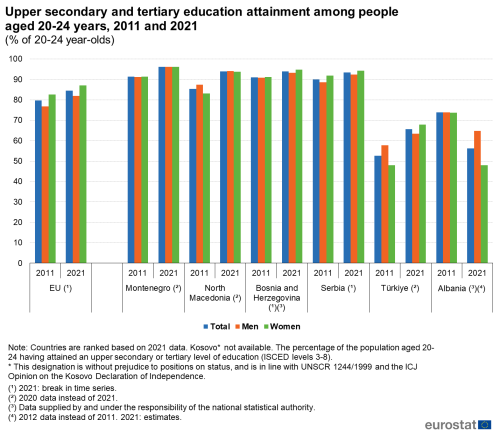
(% of 20-24 year-olds)
Source: Eurostat (edat_lfse_03) and Eurostat data collection
The proportion of persons aged 20-24 having attained at least an upper secondary level of education rose between 2011 and 2021 in almost all Western Balkans and Türkiye for which data are available; the only exception was Albania (between 2012 and 2021), where a decrease of 17.7 pp was observed. The most notable increases were in Türkiye (+13.0 pp) and North Macedonia (+8.6 pp). In the EU, the overall youth education attainment rose by 4.8 pp over the same period.
The highest change in gender gap took place in Albania with the gender gap widening by 16.7 pp, from 0.2 pp more young men than young women having attained at least an upper secondary level of education in 2012 to 16.9 pp in 2021. Türkiye had the second highest gender gap change with an increase of 14.3 pp between 2011 and 2020 (no 2021 data available), shifting the gender gap from 9.8 pp more young men than young women having attained at least an upper secondary level of education in 2011 to the opposite tendency, 4.5 pp more young women than young men in 2020 (no 2021 data available). North Macedonia recorded the third highest change in gender gap in 2021: it increased by 4.0 pp, from 4.3 pp more young men than young women having attained at least an upper secondary level of education in 2011 to 0.3 pp, which is closer to gender parity. In Serbia, the gender gap decreased from 3.3 pp more young women than young men having attained at least an upper secondary level of education in 2011 to 2.0 pp in 2021. The gender gap in Bosnia and Herzegovina was 0.4 pp more young women than young men having attained at least an upper secondary level of education in 2011, compared to 1.4 pp in 2021. The gender gap in Montenegro was similar in 2011 and 2020 (no 2021 data available), it was 0.2 pp more young women than young men having attained at least an upper secondary level of education in 2011, and 0.1 pp in 2020. Within the EU, the gender gap in youth education attainment levels stood at 5.2 pp in 2021, with a higher level of attainment for young women than for young men, to some extent diminishing the gender gap, which is still close to the one in 2011 (5.9 pp).
Tertiary education
Figure 3 shows the average change rate of students in tertiary education (ISCED levels 5-8) over the period 2016-2021. Among Western Balkans and Türkiye, there were increases in the number of tertiary students only in three out of seven countries: Kosovo (+10.1% per year), Türkiye (+5.4 % per year) and Serbia (+0.2 %). Between 2016 and 2021, an average decrease of 4.4 % per year was recorded in Bosnia and Herzegovina, an average decrease of 4.3 % per year was recorded in Albania, while smaller annual average decreases were recorded in Montenegro (-2.6 %; between 2016 and 2019 – most recent data available) and North Macedonia (-2.3 %). Some of these changes in student numbers may reflect demographic developments (for example, a growing number of young people in countries characterised by relatively high birth rates, or an overall decline in the number of young people in those countries with declining rates), rather than changes in the uptake of tertiary education among young people. In comparison, the number of tertiary education students in the EU increased on average by 0.9 % per year between 2016 and 2021.
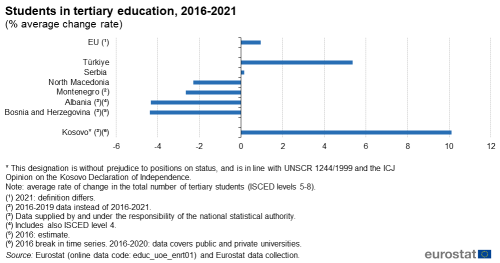
(% average change rate)
Source: Eurostat (educ_uoe_enrt01) and Eurostat data collection
Figure 4 shows the proportion of 30-34 year olds who had completed a tertiary level of education. North Macedonia reported the highest proportion among the Western Balkans and Türkiye with 39.7 % in 2020 (no 2021 data available), followed by Montenegro with 38.4 % in 2020 (no 2021 data available). Among the remaining countries, one other reported a share above one third, namely Serbia with 35.3 %. Türkiye, Albania, and Bosnia and Herzegovina reported 33.1 % (2020 data), 32.1 % and 28.8 %, respectively. Kosovo reported a proportion of 32.3% persons aged 30-34 years in 2021. All these countries reported lower proportions of 30-34 year-olds having completed a tertiary level of education than in the EU, where it stood at around two fifths (41.9 %) of this subpopulation in 2021.
When comparing to 2011, the highest increase in the proportion of 30-34 year olds who had completed a tertiary level of education was in Kosovo (+23.0 pp between 2012 – no 2011 data available - and 2021), followed by North Macedonia (+19.3 pp between 2011 and 2020), Albania (+18.8 pp between 2011 and 2021), Türkiye (+16.8 pp between 2011 and 2020), Bosnia and Herzegovina (15.4 pp between 2011 and 2021), Serbia (14.6 pp between 2011 and 2021) and Montenegro (14.3 pp between 2011 and 2020). In the EU, there was an increase of 8.5 pp between 2011 and 2021.
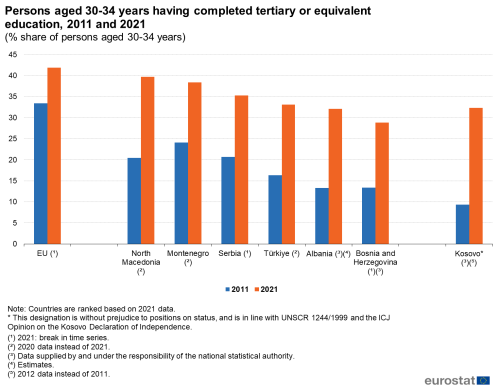
(% share of persons aged 30-34 years)
Source: Eurostat (edat_lfse_03) and Eurostat data collection
Figure 5 presents the difference between men and women among tertiary education graduates in science and technology in 2016 and 2021. In all Western Balkans and Türkiye for which data are available, there were more men than women having graduated from a science or technology discipline both in 2016 and 2021. No data was available for Kosovo.
In 2021, the lowest share of women having graduated from a science or technology discipline was observed in Türkiye, with 32.2 %, which is similar but even smaller than its share in 2016 (33.0 %). In all other countries, this share exceeded 40 % in 2021. In Albania, it was 42.9 % (-5.8 pp compared to 2016); in Serbia 44.4 % (+3.3 pp compared to 2016); in Bosnia and Herzegovina 46.3 % (+3.4 pp compared 2016); in Montenegro 47.5 % (+6.6 pp compared to 2016) and in North Macedonia 48.4 % (+1.3 pp compared to 2016).
In comparison, the share of male graduates in 2021 with a science or technology degree was 67.3 % in the EU. This was approximately twice as high as the corresponding share for women (32.7 %). The situation was similar in 2016 (66.6 % for men and 33.4 % for women).
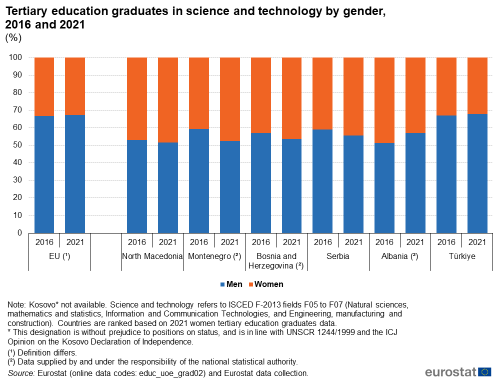
(%)
Source: Eurostat (educ_uoe_grad02) and Eurostat data collection
Source data for tables and graphs
Data sources
Data for Western Balkans and Türkiye are collected for a wide range of indicators each year through a questionnaire that is sent by Eurostat to candidate countries or potential candidates. A network of contacts has been established for updating these questionnaires, generally within the national statistical offices, but potentially including representatives of other data-producing organisations (for example, central banks or government ministries).
The main source of data for the EU aggregate is a joint UNESCO/OECD/Eurostat (UOE) questionnaire on education systems and this is the basis for the core components of the Eurostat database on education statistics; Eurostat also collects data on regional enrolments and foreign language learning. EU data on educational attainment are mainly provided through household surveys, in particular the EU labour force survey (LFS).
Education statistics cover a range of subjects, including: expenditure, personnel, participation and attainment. The standards for international statistics on education are set by three organisations:
- the United Nations Educational, Scientific, and Cultural Organisation (UNESCO) institute for statistics (UIS);
- the Organisation for Economic Cooperation and Development (OECD);
- Eurostat, the statistical office of the European Union (EU).
Tables in this article use the following notation:
| Value in italics | data value is forecasted, provisional or estimated and is therefore likely to change; |
| : | not available, confidential or unreliable value. |
Context
Each EU Member State is responsible for its own education and training systems. As such, EU policy in this area is designed to support national action and address common challenges, by providing a forum for exchanging best practices.
The strategic framework for European cooperation in education and training was adopted by the Council in May 2009, with the following common objectives for 2020:
- Making lifelong learning and mobility a reality
- Improving the quality and efficiency of education and training
- Promoting equity, social cohesion, and active citizenship
- Enhancing creativity and innovation, including entrepreneurship, at all levels of education and training
Based on the mid-term stock-taking of this strategic framework, in 2015 the Council adopted new priority areas and concrete issues for further work up to 2020, as laid down in the Joint Report from the European Commission and the Council on the implementation of the strategic framework (2015/C 417/04):
- Relevant and high-quality knowledge, skills and competences developed throughout lifelong learning, focusing on learning outcomes for employability, innovation, active citizenship and well-being.
- Inclusive education, equality, equity, non-discrimination and the promotion of civic competences.
- Open and innovative education and training, including by fully embracing the digital era.
- Strong support for teachers, trainers, school leaders and other educational staff.
- Transparency and recognition of skills and qualifications to facilitate learning and labour mobility.
- Sustainable investment, quality and efficiency of education and training systems.
In 2021, a new ‘Strategic framework for European cooperation in education and training towards the European Education Area and beyond (2021-2030)’ was adopted by Council Resolution 2021/C 66/01. This sets the following strategic priorities:
- Improving quality, equity, inclusion and success for all in education and training.
- Making lifelong learning and mobility a reality for all.
- Enhancing competences and motivation in the education profession.
- Reinforcing European higher education.
- Supporting the green and digital transitions in and through education and training.
More information concerning the current statistical legislation on education and training statistics can be found here.
While basic principles and institutional frameworks for producing statistics are already in place, Western Balkans and Türkiye are expected to increase progressively the volume and quality of their data and to transmit these data to Eurostat in the context of the EU enlargement process. EU standards in the field of statistics require the existence of a statistical infrastructure based on principles such as professional independence, impartiality, relevance, confidentiality of individual data and easy access to official statistics; they cover methodology, classifications and standards for production.
Eurostat has the responsibility to ensure that statistical production of Western Balkans and Türkiye complies with the EU acquis in the field of statistics. To do so, Eurostat supports the national statistical offices and other producers of official statistics through a range of initiatives, such as pilot surveys, training courses, traineeships, study visits, workshops and seminars, and participation in meetings within the European Statistical System (ESS). The ultimate goal is the provision of harmonised, high-quality data that conforms to European and international standards.
Additional information on statistical cooperation with Western Balkans and Türkiye is provided here.
Direct access to
Other articles
- All articles on non-EU countries
- Enlargement countries — statistical overview — online publication
- Statistical cooperation — online publication
- All articles on education and training
- Education and training in the EU - facts and figures — online publication
Publications
- Statistical books/pocketbooks
- Key figures on enlargement countries — 2019 edition
- Key figures on enlargement countries — 2017 edition
- Key figures on the enlargement countries — 2014 edition
- Factsheets
- Basic figures on the candidate countries and potential candidates — 2023 edition
- Basic figures on Western Balkans and Turkey — Factsheets — 2022 edition
- Basic figures on enlargement countries — Factsheets — 2021 edition
- Leaflets
- Basic figures on enlargement countries — 2020 edition
- Basic figures on enlargement countries — 2019 edition
- Basic figures on enlargement countries — 2018 edition
- Basic figures on enlargement countries — 2016 edition
- Enlargement countries — Demographic statistics — 2015 edition
- Key figures on the enlargement countries — Population and social conditions — 2013 edition
Database
- Participation in education and training (educ_part)
- Pupils and students - enrolments (educ_uoe_enr)
- Education and training outcomes (educ_outc)
- Educational attainment level (edat)
- Population by educational attainment level (edat1)
- Transition from education to work (edatt)
- Early leavers from education and training (edatt1)
- Educational attainment level (edat)
- Education administrative data until 2012 (ISCED 1997) (educ_uoe_h)
- Education indicators - non-finance (educ_indic)
- Distribution of pupils/ students by level (educ_ilev)
- Tertiary education graduates (educ_itertc)
- Enrolments, graduates, entrants, personnel and language learning (educ_isced97)
- Students by ISCED level, age and sex (educ_enrl1tl)
- Education indicators - non-finance (educ_indic)
Dedicated section
Methodology
- Education administrative data from 2013 onwards (ISCED 2011) (ESMS metadata file — educ_uoe_enr_esms)
- Strategic framework for European cooperation in education and training (COM(2008) 865 final)
- Joint Report from the European Commission and the Council on the implementation of the strategic framework (2015/C 417/04)
- Strategic framework for European cooperation in education and training towards the European Education Area and beyond (2021-2030)’ (Council Resolution 2021/C 66/01)
External links
- Directorate-General for European Neighbourhood Policy and Enlargement Negotiations
- Directorate-General for Education and Training
- Education, training and youth
- Strategic framework for European cooperation in education and training (ET 2020)
- Education and Training Monitor – annual publication on national education and training systems in the EU
- Erasmus+